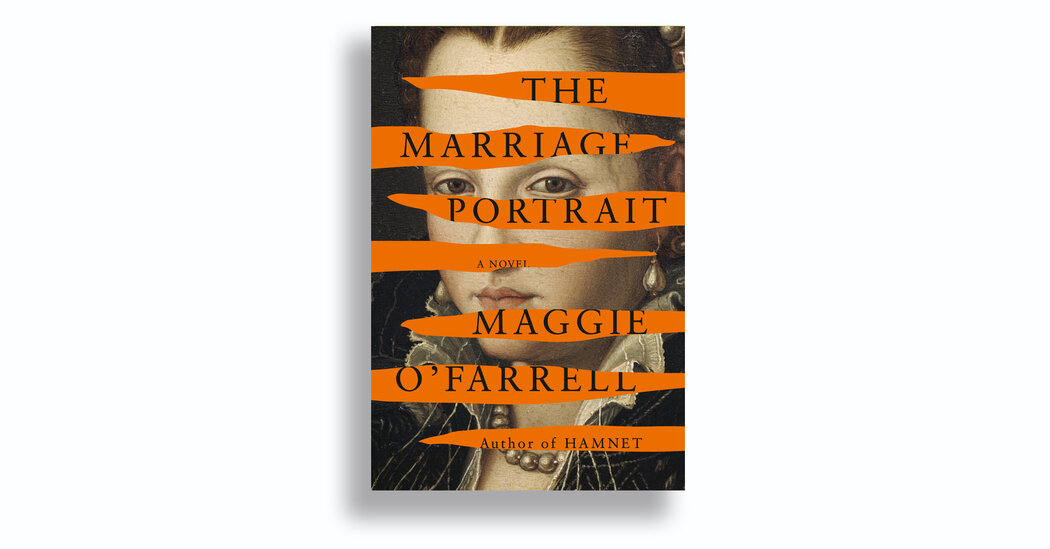Sex and Murder in Maggie O’Farrell’s Overwrought Historical Drama

THE MARRIAGE PORTRAIT, by Maggie O’Farrell
Does great sex yield great children? Norman Mailer thought so (of course), but other writers have circled this topic, too. If you have a blah night in bed when you and your partner conceive, maybe it’s a karma thing — maybe you’ll have a blah kid.
Early in Maggie O’Farrell’s new novel, “The Marriage Portrait,” the Duchess Eleanora finishes making love with her husband, the Grand Duke of Tuscany. The year is 1544. The setting: a palace in Florence.
The grand duke wraps up happily, and mightily, with “his habitual howling gasp,” but Eleanora knows something is amiss. She’d been inattentive, staring at troubling images on the walls — maps filled with “strange and wild seas, filled with dragons and monsters” — instead of keeping her mind on her own storied fecundity.
Her previous children are well mannered. But Lucrezia, who emerges nine months later? She is “squalling,” “intractable,” “unbiddable,” “inconsolable” and “savage.” Like an animal, she prefers to eat her food off the floor. She screams for days; she’s banished to the basement kitchen.
We get it: Lucrezia is a pint-size hell-raiser. By Page 15 of “The Marriage Portrait,” we also get that this historical novel is verging on the steamy and operatic. Then we’re introduced to the tiger, and we should talk about the tiger.
The grand duke wants the animal to complete his menagerie, because tigers are (cue the hammy Vincent Price vocals) “vicious, singular beasts.” This is about where “The Marriage Portrait” begins to boil over and the C.G.I. effects kick into motion.
“The tigress didn’t so much pace as pour herself,” O’Farrell writes, “as if her very essence was molten, simmering, like the ooze from a volcano.” Ooze is the right word.
She continues: “The animal was orange, burnished gold, fire made flesh; she was power and anger, she was vicious and exquisite.” The tiger’s cry is a “yearning, desperate rasp.”
O’Farrell is most notably the author of “Hamnet,” a largely fictional account of the life and early death of Shakespeare’s son; it won a National Book Critic’s Circle prize in 2021. Some of the prickliest and most committed readers I know take “Hamnet” seriously.
“Hamnet” wasn’t ridiculous in the way that “The Marriage Portrait” is ridiculous; at its best it was an affecting portrait of grief. But it too went in for lush atmospherics, for a lot of rustling leaves, for creating scenes that longed to be bowers of enchantment.
It, too, had few sharp perceptions, little wit and little humble sense of life as it is lived down near the ground. Reading each Ipined instead — for the reason one goes to a good restaurant — something simple and unpretending.
A.S. Byatt once told The Paris Review that to read Tolkien, you need to do so primitively. “If you start thinking,” Byatt said, “you’ve got to stop reading.” Maybe that’s the trick with “Hamnet” and “The Marriage Portrait,” too.
(My favorite O’Farrell novel is the earthier “Instructions for a Heatwave,” from 2013, in which a young woman arriving in New York does so “like someone who trips when they enter a room.”)
“The Marriage Portrait” tells the somewhat true story of Lucrezia di Cosimo de’Medici, who at 15 was forced by her parents to marry the older Alfonso II d’Este, Duke of Ferrara, thus merging two dynasties.
Alfonso spirits her away to a different palace, where she suffers. She is subject to totalitarian surveillance. She is kept largely to herself, but like Van Gogh she has a great ear. She can hear intrigue through walls and around the corners of passageways.
Outside, nature is, like the tiger, vicious and exquisite. The Po River laps at its banks with “lassitudinous ochre tongues.” Inside, Lucrezia’s heart is fearsome and full: “Flames, vibrant and consoling, lick at her insides, a fire kindles, cracks and smolders.”
When she speaks, others lean in, “as if every syllable Lucrezia spoke was a fragile airborne filament of gold.”
In the first chapter we learn that Alfonso probably intends to kill Lucrezia, in part because she has been unable, though the fault is his, to conceive an heir. As with “Hamnet,” scenes jump artily back and forth in time, postponing this reckoning.
A second sort of reckoning looms. Lucrezia will have to sleep with Alfonso at some point, and the moment is delayed for as long as possible. Things build to a crescendo Bernard Herrmann would envy. The sex is as awful as we know it will be: “burning, invading, unwelcome.”
But a dynasty is at stake, and Lucrezia must be ruthlessly pollinated. The novel’s later sex scenes have overtones of “The Shape of Water,” the Guillermo del Toro movie.
Alfonso becomes like “a river god, a water monster” with “the hidden gills in his neck pulsing and pulsing.” His face is a “grotesque mask above her: a face of fury, of intent, of unslakable need.”
You hope Lucrezia might be fertilized by a shower of light, the way Zeus impregnated Danae, and thus spared. You also hold out hope that this victim will ultimately become a destroyer.
Murder and unwanted sex are primal drivers of narrative. In this novel the characters are so one-dimensional and overwrought that the force of neither driver lands. The novelist begins to resemble a conjurer forcing cards.
Anyway, as Elizabeth Hardwick put it, “If I want a plot I’ll watch ‘Dallas.’”
THE MARRIAGE PORTRAIT, by Maggie O’Farrell | 348 pp. | Alfred A. Knopf | $28
